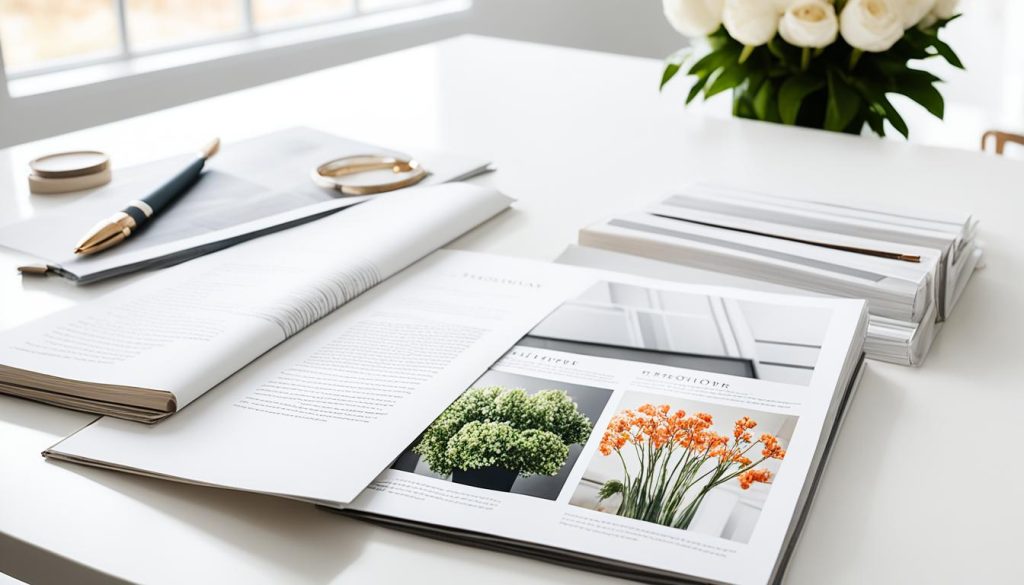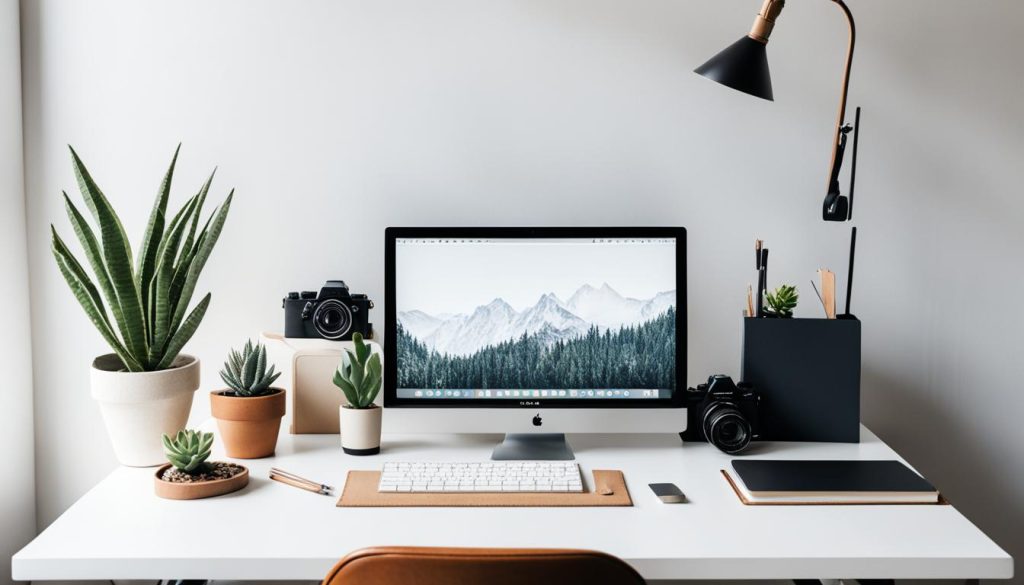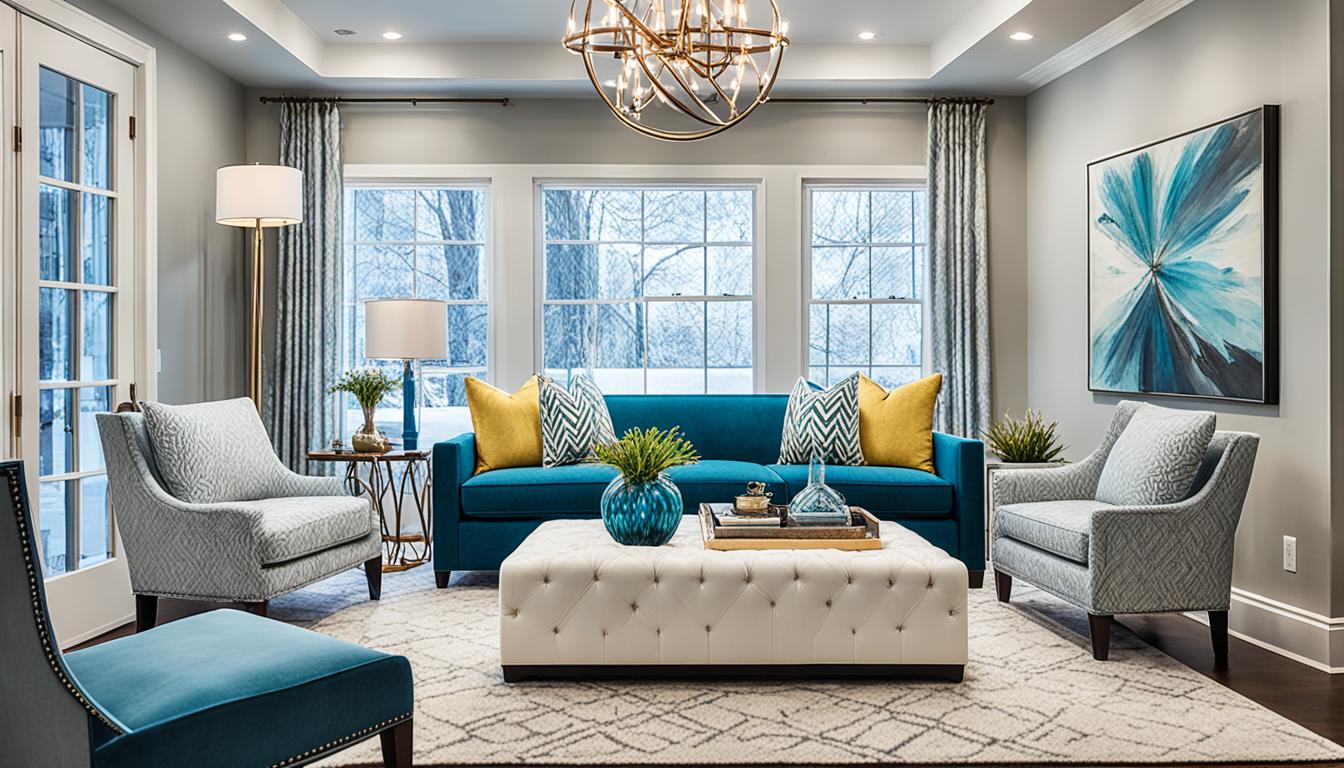When it comes to landing new clients and opportunities in the competitive design industry, your portfolio is your ultimate weapon. It serves as a visual testament to your skills, creativity, and expertise, making it crucial to invest time and effort into creating a standout portfolio that captivates clients and sets you apart from the crowd.
In this article, I will share various tips and strategies on how to make an interior design portfolio that not only showcases your talent but also leaves a lasting impression on potential clients and employers. From building a solid foundation to curating your portfolio with precision, we’ll cover all the essential aspects to help you craft a portfolio that speaks volumes about your design prowess.
Key Takeaways:
- Crafting a standout interior design portfolio is crucial for aspiring designers.
- Document your work by photographing every project, no matter how minor.
- Establish a strong online and offline brand presence to maximize your reach.
- Curate your portfolio carefully, handpicking projects that showcase your versatility and unique style.
- Infuse your portfolio with personal narratives, passion, and dedication to stand out.
Starting from Scratch: Building a Foundation
When beginning a career in interior design, creating a professional portfolio is essential. It allows you to showcase your skills, creativity, and unique design perspective. Building a strong foundation is the first step towards crafting an impressive portfolio. Start by taking on small projects, even if they may not be the high-end assignments you dream of. Each consultation, room rearrangement, or paint recommendation presents an opportunity to learn and grow.
Documenting your work is crucial, no matter how minor the project may seem. Photographing every project provides tangible proof of your progress and becomes valuable content for your portfolio. By including these diverse projects, you demonstrate your ability to handle a range of design challenges and showcase your versatility.
In addition to client projects, be sure to include hand renderings, sketches, academic work, and personal design projects in your portfolio. These pieces allow you to exhibit your creativity, problem-solving skills, and unique design vision. They give potential clients and employers insight into your thought process and ability to think outside the box.
As you build your portfolio, keep in mind that it is an ever-evolving showcase of your professional journey. Regularly update and refresh your portfolio to ensure you are always presenting your best and most relevant work. Curate your projects carefully, selecting those that truly highlight your skills and style. Alongside each project, provide detailed descriptions that showcase the materials used, challenges faced, and innovative solutions employed. This information allows potential employers to gain a deeper understanding of your design process and capabilities.
By starting from scratch and building a solid foundation, you lay the groundwork for a professional portfolio that reflects your skills, creativity, and unique design perspective. With each project, challenge yourself to grow, learn, and refine your craft, ensuring that your portfolio remains current, compelling, and impactful.
Maximizing Your Reach: Building Online and Offline Brand Presence
In the modern era, it’s important for interior designers to establish a strong brand presence both online and offline. As a designer, showcasing your work and expertise is crucial to attracting clients and creating opportunities for growth.
One effective way to showcase your design work is through social media platforms like Instagram. Curate a visually appealing feed that reflects your unique style and showcases your best projects. Share inspiring visuals, behind-the-scenes looks, and design tips to engage with your followers and attract potential clients.
An important aspect of building an online brand presence is creating a digital portfolio. Utilize user-friendly platforms like DecorMatters to bring your work to life and make it accessible to potential clients at all times. Showcase your best projects, highlight your design process, and provide clear contact information for interested clients to reach out.
While the digital world is important, don’t underestimate the power of a physical portfolio. A tangible portfolio can create a memorable experience during face-to-face interactions with potential clients or employers. Use high-quality prints and consider incorporating unique design elements to make your portfolio stand out.
Building an offline brand presence goes beyond just portfolios. Engage in industry events, such as trade shows, conferences, or design exhibitions, to connect with fellow professionals and potential clients. These events provide valuable networking opportunities and the chance to stay updated on the latest design trends and innovations.
Seeking feedback from mentors and peers is another way to expand your network and enhance your brand presence. Valuable insights and advice from experienced designers can help you refine your skills and stay ahead in the ever-changing design industry.
Overall, building a strong online and offline brand presence is vital for interior designers. By showcasing your design work, utilizing social media platforms, creating a digital and physical portfolio, and engaging in industry events, you can maximize your reach and establish yourself as a reputable and in-demand designer.
Curating Your Portfolio
A standout interior design portfolio is not a static entity but an evolving showcase of your professional journey. Regularly update and refresh your portfolio to ensure you’re always putting your best and most relevant work forward. Curate your projects carefully, handpicking those that truly showcase your versatility, skill, and unique flair.
Each chosen project should be accompanied by detailed descriptions that highlight the materials used, challenges faced, and innovative solutions employed. This provides potential employers with insight into your problem-solving skills, creativity, and attention to detail.
For inspiration, take a look at these design portfolio examples:
- Interior Design Portfolio Example 1
- Interior Design Portfolio Example 2
- Interior Design Portfolio Example 3
These design portfolios provide inspiration and insights into different approaches and styles. Use them as references to refine your own portfolio and to push your creativity further.
Interior Design Portfolio Inspiration
When curating your portfolio, it’s important to seek interior design portfolio inspiration and learn from the best in the industry. Look for renowned interior designers and browse through their portfolios to gain insights into their unique styles and presentation techniques.
One renowned interior designer, Jane Smith, has created an awe-inspiring portfolio that demonstrates her mastery of combining elegant aesthetics with functional design. Her portfolio showcases a variety of projects, ranging from residential homes to commercial spaces, each displaying her meticulous attention to detail and innovative design solutions. Jane’s portfolio is a source of constant inspiration for young designers looking to elevate their own work.

Beyond the Portfolio: Standing Out in the Crowd
While a well-crafted portfolio is essential, it’s your unique essence, ongoing commitment to growth, and dedication to the craft that will truly make you stand out as an interior designer. Continuously hone your skills through workshops, webinars, and staying updated on the latest design trends. Incorporate testimonials from satisfied clients or colleagues in your portfolio to bolster your credibility. Embrace new technologies and mediums like videos or 3D renderings to showcase your work in innovative ways. By infusing your portfolio with personal narratives, passion, and dedication, you will leave a lasting impression on potential clients and employers.

| Ways to Stand Out: | Benefits |
|---|---|
| Continuously Hone Skills | Showcases growth and expertise |
| Incorporate Testimonials | Builds trust and credibility |
| Embrace New Technologies | Demonstrates innovation and adaptability |
| Infuse Personal Narratives | Creates a memorable and unique brand |
Preparing for the Interview and Presentation
When it comes to creating a professional portfolio and showcasing your design work, preparation is key. As you get ready for an interview or presentation, here are some essential tips to help you make a lasting impression on potential employers or clients.
- Tailor your portfolio: Before any interview or presentation, take the time to understand the specific requirements and preferences of the job or client. Customize your portfolio to showcase projects and designs that align with their vision and needs.
- Customize your presentation: Along with tailoring your portfolio, adapt your presentation style to reflect the client’s or employer’s values and preferences. This personalized approach shows that you’ve done your homework and are invested in meeting their expectations.
- Practice articulating your work: Be prepared to share the stories behind each design choice, the challenges you faced, and the innovative solutions you implemented. This demonstrates your problem-solving abilities and highlights your passion and dedication to your craft.
- Engage in active listening: During interviews, actively listen to the questions and feedback provided. Ask insightful questions that show your genuine interest in the project or role. This level of engagement fosters a collaborative atmosphere and allows you to showcase your eagerness to learn and grow.
By following these guidelines, you’ll be well-prepared to showcase your design work and make a strong impression during interviews and presentations. Remember, it’s not just about your portfolio; it’s also about your ability to communicate your ideas, engage with others, and demonstrate your commitment to creating exceptional designs.
| Key Tips for Preparing for Interviews and Presentations |
|---|
| Tailor your portfolio to match the requirements and preferences of the job or client. |
| Customize your presentation to reflect the client’s or employer’s vision and needs. |
| Practice articulating the stories behind your design choices, challenges faced, and solutions implemented. |
| Engage in active listening, ask insightful questions, and seek feedback. |
Common Mistakes to Avoid
When creating your interior design portfolio, it’s crucial to steer clear of common mistakes that can hinder your success. One of the most common errors is including too much content, which can overwhelm potential clients or employers. Instead, focus on showcasing your best and most relevant work to make a strong impression.
Misrepresentation is another pitfall to avoid. Be honest and transparent about your contributions to projects. This builds trust and credibility among potential clients, allowing them to see the true value you bring to the table.
The presentation and organization of your portfolio matter as well. Neglecting these aspects can detract from the impact of your showcased work. Ensure your portfolio has a clean and consistent layout, with high-quality images and a coherent structure. This will make it easier for viewers to navigate and appreciate your designs.
Lastly, remember that a portfolio is a living document that should evolve with your growth as a designer. Regularly update and refine it to reflect your latest projects, skills, and accomplishments. By continuously improving your portfolio, you’ll demonstrate your dedication to your craft and stay ahead in the competitive world of interior design.
